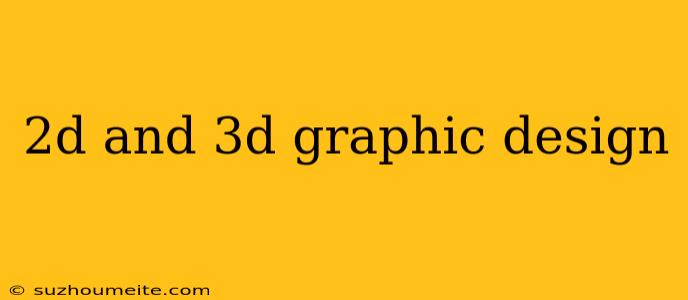2D and 3D Graphic Design: Understanding the Difference
Graphic design is an essential aspect of visual communication, and it can be categorized into two main types: 2D and 3D graphic design. While both types are used to convey messages and create visually appealing designs, they differ in their approach, techniques, and applications. In this article, we will delve into the world of 2D and 3D graphic design, exploring their characteristics, advantages, and uses.
What is 2D Graphic Design?
2D graphic design, also known as two-dimensional design, involves creating flat, two-dimensional images using various design elements such as lines, shapes, colors, and textures. These designs are typically created using computer software like Adobe Illustrator, Photoshop, or Sketch.
Characteristics of 2D Graphic Design
- Flat, two-dimensional images
- Uses lines, shapes, colors, and textures to create designs
- Can be created using computer software or traditional drawing techniques
- Often used for print materials, digital displays, and web design
Advantages of 2D Graphic Design
- Faster and more cost-effective to produce
- Easier to edit and modify
- Well-suited for simple, text-based designs
- Can be easily scaled up or down without losing quality
Uses of 2D Graphic Design
- Logos, icons, and branding materials
- Brochures, flyers, and other print materials
- Web design, including UI/UX design
- Social media graphics and advertising
What is 3D Graphic Design?
3D graphic design, also known as three-dimensional design, involves creating three-dimensional models or environments using computer software like Blender, Maya, or 3ds Max. These designs can be used in various industries, including film, video games, architecture, and product design.
Characteristics of 3D Graphic Design
- Three-dimensional models or environments
- Uses mathematical equations and algorithms to create designs
- Can be created using computer software or traditional modeling techniques
- Often used for film, video games, architecture, and product design
Advantages of 3D Graphic Design
- Can create realistic and interactive designs
- Can be used to create immersive experiences
- Allows for precise control over lighting, textures, and materials
- Can be used to create detailed models and simulations
Uses of 3D Graphic Design
- Film and animation production
- Video game development
- Architectural visualization and design
- Product design and prototyping
Key Differences between 2D and 3D Graphic Design
While both 2D and 3D graphic design are used to create visually appealing designs, there are some key differences between the two:
- Dimensionality: 2D design is flat and two-dimensional, while 3D design is three-dimensional and can be interactive.
- Software: 2D design typically uses software like Adobe Illustrator or Photoshop, while 3D design uses software like Blender or Maya.
- Applications: 2D design is often used for print materials, web design, and branding, while 3D design is used for film, video games, architecture, and product design.
Conclusion
In conclusion, 2D and 3D graphic design are both essential aspects of visual communication, but they differ in their approach, techniques, and applications. Understanding the characteristics, advantages, and uses of each type of design can help designers and businesses choose the right approach for their projects. Whether you're creating a logo, a video game, or a product prototype, knowledge of 2D and 3D graphic design can help you create visually stunning and effective designs.
